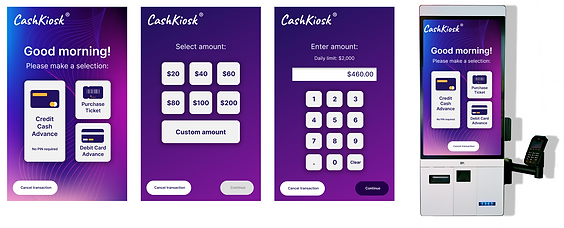Casino Fintech
PROJECT TYPE
Post-research analysis, personas, and UI recommendations for casino Fintech.
CLIENT
Everi Holdings
MY ROLE
UX Researcher / Lead Designer

CashClub: A kiosk app shaped by data
PROJECT OVERVIEW
Our UX team was tasked with designing the interface for their new Prelude Series self-service kiosk, a product aimed at reducing teller line congestion by streamlining transactions.
To ensure the solution aligned with real-world behaviors, we began with user research, including field observations, patron interviews, and stakeholder insights. These findings directly shaped the product strategy and informed every stage of design, from early wireframes and prototypes to high-fidelity mockups tailored for touch interaction and accessibility.

PROJECT TIMELINE

PROBLEM STATEMENT
Casino patrons frequently face long wait times at teller stations when exchanging cash for chips, leading to frustration and lost gaming time.
Existing kiosks and ATMs often confuse users due to unclear interfaces and lack of trust signals, causing hesitation or errors that further slow down transactions.
The challenge was to design a self-service kiosk experience that reduces teller line congestion by speeding up voucher purchases while building user confidence across diverse patron demographics.
DESIGN GOALS
-
Simplify the transaction flow to minimize steps and reduce time-on-task, enabling quick voucher purchases even for first-time users.
-
Build trust and clarity through clear messaging, confirmation feedback, and physical printouts to reassure patrons about the legitimacy of their vouchers.
-
Accommodate diverse users, including older patrons and super-users, by designing for accessibility, straightforward navigation, and customizable voucher options.
-
Maintain anonymity and ease of use by avoiding complex logins or personal data requirements.
-
Support rapid iteration and validation by creating prototypes informed directly by user research insights.
UX RESEARCH
Insight-to-Design Mapping Matrix

PERSONA-INFORMED DESIGN
Our ethnographic interviews and usability tests revealed that even tech-comfortable users like Jennifer (see persona card below) are frustrated by:
-
Lack of real-time feedback: they want confirmation that the transaction worked without having to ask a staff member.
-
Vague instructions or unclear progress states: Jennifer expects the machine to tell her what’s next without thinking too hard.
-
Missing physical proof: even though she’s digital-first, Jennifer appreciates having the option to print something as a backup, especially when it involves money.

Jennifer is tech-savvy, decisive, and impatient with anything that slows her down. She's not fearful of using technology, but she expects clarity, speed, and reassurance. Your research showed that users like her are quick to abandon a process if it feels uncertain or poorly communicated, especially when money is involved.
Here's how we reflected those insights in the interface design:
1. Minimal Tap-to-Action Flow
Persona Insight: Jennifer is impatient with multi-step tasks and wants to “get in and get out.”
Design Response: We minimized the number of decisions she has to make on each screen. Key actions were surfaced clearly with bold CTAs and defaults, letting her breeze through common actions (like cashing a set amount or reprinting a voucher) with minimal friction.

2. Printed Voucher for Trust
Persona Insight: While she’s used to digital tools, Jennifer still values a backup, especially when money’s involved. She doesn’t want to be left wondering if her digital voucher will be honored.
Design Response: The kiosk prints a physical voucher with a timestamp and a verification code. This addresses both emotional and practical needs: she can trust the process, and she has proof of the transaction if anything goes wrong.
